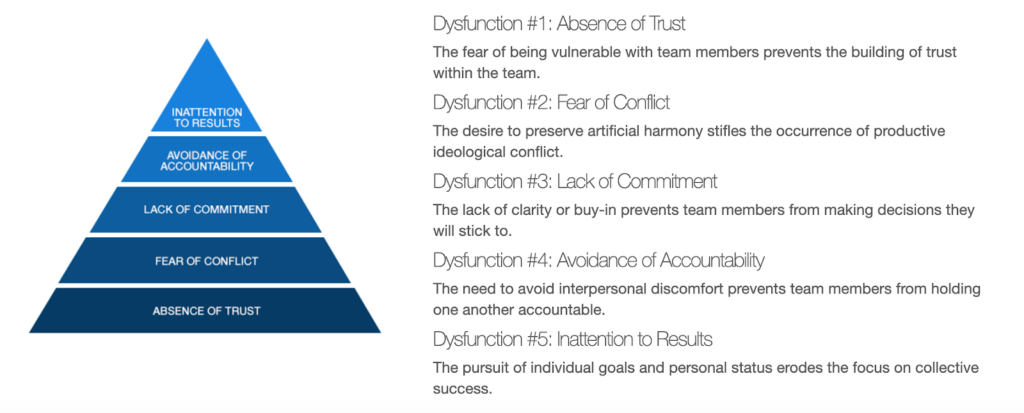High-Performing teams are increasingly becoming a competitive advantage because while competitors may copy your process or product, they cannot copy your people.
In his popular business fable, “The Five Dysfunctions of a Team”, author and management consultant Patrick Lencioni describes five common obstacles (dysfunctions) that prevent teams from executing at their best. While these issues do not disappear easily, the most cohesive and effective teams intentionally practice and improve these five areas:

Fostering Trust
While many teams put up facades to protect ego or hold back from sharing information to avoid discomfort, Lencioni describes how the best teams create environments that foster vulnerability-based trust. More than just representing credibility, trust in this sense is about team members being open and genuine with one another by expressing things like “I made a mistake”, “you’re better at that than me” or “I need help”.
–
Here’s another quick read for fostering trust.
–
How can trust be developed?
- Modeling. It’s important for the leader to go first. The team will emulate what they see in the leader. Leaders adept in building trust ask questions more than they overtly state directives. They listen and invite input. They openly admit shortcomings which reduces fear others may have in doing the same.
- Understanding Work Styles. So much can be gained when team members have a clearer picture of why certain dynamics arise on a team. Behavioral assessments such as DiSC or MBTI provide a unique lens through which the team can experience one another’s communication and collaboration preferences.
- Get to Know Each Other Personally. Humanizing the work experience goes a long way toward building trust. As the volume of shared experiences among team members increases (social or work-related) so does the level of trust. Short ice-breakers in team meetings, fun-focused events and things like team lunches all help teammates connect on a person, informal level.
–
Embracing Productive Conflict
Disagreeing with teammates can create discomfort for many, yet no one would argue that it’s healthy for everyone on a team to agree with each other all the time either. With a foundation of vulnerability-based trust, the most effective teams have the courage to passionately debate ideas (a.k.a. “attack the problem not the person”) in order to get more ideas out on the table and ultimately the best solution with complete buy-in.
–
How can productive conflict occur?
–
- Create the environment. See behavior #1. It is very difficult if not impossible to foster productive conflict without an atmosphere of trust. Team members will not risk saying something controversial or adversarial if they cannot trust how others will react to that vulnerability.
- Mine for conflict. Ask people to engage, solicit input and spark debate with the intent to seek more information in pursuit of the best decision.
- Recognize healthy conflict. When you see respectful debate that is also a little uncomfortable, stop and address those involved encouraging them that the productive conflict is helpful and ask them to continue.
–
Here’s another quick read for mastering productive conflict.






